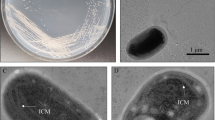Abstract
A pure colony of a bacterium from contaminated soil was isolated by exploiting 3,6-dimethyl-1-keto-1,2,3,4–tetrahydrocarbazole, a novel carbazole derivative, having indole moiety as well as 3-methyl functionality both in aromatic and hydro-aromatic moiety, as a sole source of carbon and energy. Taxonomical studies, biochemical analysis, and 16S rDNA sequence analysis indicated that the isolated strain has close similarity with Pseudomonas sp. Thin-layer chromatography followed by HPLC and mass spectroscopic study indicates that the isolated Pseudomonas sp. STM 997 degrades 3,6-dimethyl-1-keto-1,2,3,4–tetrahydrocarbazole, and this strain may be useful in the bioremediation of environments contaminated by the compounds containing carbazole moiety with methyl substituents at various reactive sites. This study also provides an evidence in favor of the suggested biodegradation of 3-methylcarbazole to carbazole in plants.












Similar content being viewed by others
References
Muller, J. G., Chapman, P. J., & Pritchard, P. H. (1989). Creosote contaminated sites. Environmental Science & Technology, 23, 1197–1201.
Benedik, M. J., Gibbs, P. R., Riddle, R. R., & Willson, R. C. (1998). Microbial denitrogenation of fossil fuels. Trends in Biotechnology, 16, 390–395.
Goerlitz, D. F., Troutman, D. E., Godsy, E. M., & Franks, B. J. (1985). Migration of wood preserving chemicals in contaminated ground water in a sand aquifer at Pensacola, Florida. Environmental Science & Technology, 19, 55–961.
Grosser, R. J., Warshawaky, D., & Vestal, J. R. (1991). Indigenous and enhanced mineralization of pyrene, benzo[a]pyrene and carbazole in soils. Applied and Environmental Microbiology, 57, 3462–3469.
Santodonato, J., & Howard, P. H. (1981). Azaarenes: source, distribution, environmental impact and health effects. In J. Saxena & F. Fisher (Eds.), Hazard assessment of chemicals: current developments (pp. 421–440). New York: Academic.
West, W. R., Smith, P. A., Booth, G. M., & Lee, M. L. (1986). Determination and genotoxicity of nitrogen heterocycles in a sediment from the Black River. Environmental Toxicology and Chemistry, 5, 511–519.
O’Brien, T., Schneider, J., Warshawsky, D., & Mitchell, K. (2002). In vitro toxicity of 7H-dibenzo[c, g]carbazole in human liver cell lines. Toxicology In Vitro, 16, 235–243.
Arcos, J. C., & Argus, M. F. (1968). Molecular geometry and carcinogenic activity of aromatic compounds. New perspectives. Advances in Cancer Research, 11, 305–471.
Reddy, M. Y., & Randerath, K. (1990). A comparison of DNA adduct formation in white blood cells and internal organs of mice exposed benzo[a]pyrene, benzo[c, g]carbazole, safrole and cigarette smoke condensate. Mutation Research, 241, 37–48.
Jha, A. M., & Bharti, M. K. (2002). Mutagenic profiles carbazole in the male germ cells of Swiss albino mice. Mutation Research, 500, 97–101.
Xia, W., Zhonghui, G., Bo, Y., Jinhui, F., Changyong, X. U., Yong, Y., et al. (2007). Degradation of carbazole by microbial cells immobilized in magnetic gellan gum gel beads. Applied and Environmental Microbiology, 73(20), 6421–6428.
Gieg, L. M., Otter, A., & Fedorak, P. M. (1996). Carbazole degradation by Pseudomonas sp. LD2: metabolic characteristics and the identification of some metabolites. Environmental Science & Technology, 30, 575–585.
Kobayashi, T., Kurane, R., Kenji, N., Nakamura, Y., Kirimura, K., & Usami, S. (1995). Isolation of bacteria degrading carbazole under micro-aerobic conditions, i.e. nitrogen gas substituted conditions. Bioscience, Biotechnology, and Biochemistry, 59, 932–933.
Schneider, J., Grosser, R. J., Jayasimhulu, K., Xue, W., Kinkle, B., & Warshawsky, D. (2000). Biodegradation of carbazole by Ralstonia sp. RJGII, 123 isolated from a hydrocarbon contaminated soil. Canadian Journal of Microbiology, 46, 269–277.
Chowdhury, B. K., & Chakraborty, D. P. (1971). Mukoeic acid, the first carbazole carboxylic acid from a plant source. Phytochemistry, 10, 1967–1970.
Knolker, H.-J., & Reddy, K. R. (2002). Isolation and synthesis of biologically active carbazole alkaloids. Chemical Reviews, 102, 4303–4427.
Yamasaki, K., Kenda, M., Watanabe, K., Ueki, Y., Ishamaru, S., & Nakamura, T. (1983). New antibiotics, carbazomycins A and B. III. Taxonomy and biosynthesis. The Journal of Antibiotics, 36, 552–558.
Chakroborty, S., Chattopadhyay, G., & Saha, C. (2010). Montmorrilonite-KSF induced Fischer indole cyclization under microwave towards a facile entry to 1-keto-1,2,3,4-tetrahydrocarbazole. Indian Journal of Chemistry, 50B, 201–206.
Saha, C., Chakraborty, A., & Chowdhury, B. K. (1996). A new synthesis of 4-deoxycarbazomycin B and its antimicrobial properties. Indian Journal of Chemistry, 35B, 677–680.
Holtz, J. D. (1993). Bergey’s manual of determinative bacteriology (9th ed.). Baltimore: Williams and Wilkins.
Lane, D. J. (1991). 16/23S rRNA sequencing. In E. Stackebrandt & M. Goodfellow (Eds.), Nucleic acid techniques in bacterial systematics (pp. 115–175). Chichester: Wiley.
Thompson, J. D., Gibson, T. J., Plewniak, F., Jeanmougin, F., & Higgins, D. G. (1997). The ClustalX windows interface: flexible strategies for multiple sequence alignment aided by quality analysis tools. Nucleic Acids Research, 24, 4876–4882.
Li, L., Li, Q., Li, F., Shi, Q., Yu, B., Liu, F., et al. (2006). Degradation of carbazole and its derivatives by a Pseudomonas sp. Applied Microbiology and Biotechnology, 73, 941–948.
Acknowledgments
The authors are thankful to Prof. Krishnangshu Roy, Director, Prof. Tamal Ghosh, MSVP, and Prof. Santanu Tripathi, Head of the Department of Clinical & Experimental Pharmacology, School of Tropical Medicine, Kolkata, for their interest in the work. The authors would like to acknowledge Dr. Sanjoy Ghosh, Department of Biochemistry, University of Calcutta for helpful suggestions. We are also thankful to the Council of Scientific and Industrial Research (CSIR), New Delhi, India for providing a Senior Research Fellowship (grant no. 09/951(0001)/2008-EMR-I) to one (SC) of the authors.
Author information
Authors and Affiliations
Corresponding author
Rights and permissions
About this article
Cite this article
Chakraborty, B., Chakraborty, S., Basu, A.K. et al. Isolation and Characterization of Pseudomonas sp. STM 997 from Soil Sample having Potentiality to Degrade 3,6-Dimethyl-1-keto-1,2,3,4-tetrahydrocarbazole: A Novel Approach. Appl Biochem Biotechnol 168, 1765–1777 (2012). https://doi.org/10.1007/s12010-012-9895-1
Received:
Accepted:
Published:
Issue Date:
DOI: https://doi.org/10.1007/s12010-012-9895-1




